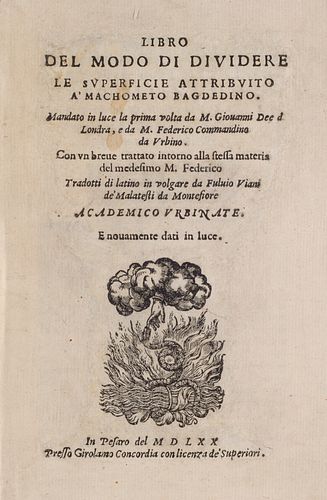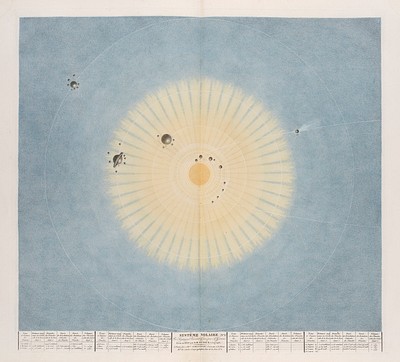Libro del Modo di Dividere
Lot 42
Absentee vs Live bid
Two ways to bid:
- Leave a max absentee bid and the platform will bid on your behalf up to your maximum bid during the live auction.
- Bid live during the auction and your bids will be submitted real-time to the auctioneer.
Bid Increments
| Price | Bid Increment |
|---|---|
| EUR€0 | EUR€10 |
| EUR€100 | EUR€10 |
| EUR€200 | EUR€20 |
| EUR€300 | EUR€30 |
| EUR€420 | EUR€30 |
| EUR€480 | EUR€20 |
| EUR€500 | EUR€50 |
| EUR€2,000 | EUR€200 |
| EUR€3,200 | EUR€300 |
About Auction
By Jeschke Jádi Auctions Berlin GmbH
Dec 15, 2022
Set Reminder
2022-12-15 09:00:00
2022-12-15 09:00:00
America/New_York
Bidsquare
Bidsquare : Auction 145 – Rare Books, Decorative Prints, Historical Photography
https://www.bidsquare.com/auctions/jeschke-van-vliet/auction-145-rare-books-decorative-prints-historical-photography-11466
Jeschke Jádi Auctions Berlin GmbH info@jvv-berlin.de
Jeschke Jádi Auctions Berlin GmbH info@jvv-berlin.de
- Lot Description
Mathematik Muhammad al-Baghdadi Libro del Modo di Dividere le superficie attribuito a Machometo Bagdedino. Mandato in luce la prima volta da M. Giovanni Dee da Londra, e da M. Federico Commandino da Urbino. Con un breve trattato intorno alla stessa materia del medesimo M. Federico. Mit Holzschnitt-Druckermarke, -Bordüren u. Initialen sowie zahlr. Figuren im Text. Pesaro, Girolamo Concordia, 1570. 44 Bl. 8°. Pgt. d. 18. Jh. (Schließbänder fehlen, fleckig). First edition. With woodcut printer's mark, borders and initials as well as numerous figures in the text. 18th century vellum (ties missing, stained). - Italian version, of this fragment of Muhammad al-Baghdadi's on the division of surfaces, published parallel in separate editions in the same year and place with a Latin edition under the title: 'De superficiorum divisionibus'. As the title indicates it was published through the collaboration of the English mathematician, astronomer, astrologer and alchemist John Dee (1527-1608) and the Italian humanist and mathematician Federico Commandino (1509-1575). In the prefatory letter to Commandino, Dee was inclined to trace the origin of the work to Euclid (Euclid's lost work 'De superficierum divisionibus') rather than to the Arab geometer to whom the manuscript was ascribed. This faintly classical Euclidean attribution was wrong, but might have encouraged Dee and Commandino to publish the book in Latin and in Italian translation as part of the systematic revival of Greek mathematics. Commandino added an appendix to the Arabic work where he outlines two problems generalizing Machometus' rather specific treatment. Dee's statement of the case in his letter to Commandinus is as follows: "As the authors name, I would have you understand, that to the very old copy from whence I write it, the name of Machomet Bagdedine was put in ziphers or characters, (as they call them) who whether he were that Albategnus (Gebir ibn Al-Battani) whom Copernicus often cites as a very considerable Author in Astronomie, or that Machomet who is said to have been Alkindus's scholar, and is reported to have written somewhat of the art of Demonstration, I am not yet certain of: or rather that this may be deemed a Book of our Euclide, all whose Books were long since turned out of the Greeke into the Syriack or Arabick Tongues. Whereupon, it being found some time or other to want its title with the Arabians or Syrians, was easily attributed by the transcribers to that famous Mathematician among them, Machomet ..." - Title page re-margined, margins trimmed, older ink annotation, occ. minor staining, first 2 leaves with small defect in the white margin, last 2 leaves slight mould marks, otherwise overall well preserved. Erste Ausgabe. - DSB XV, 9-10. - Riccardi I, 361. - Brunet I, 609. - Nicht in Adams, nicht in Honeyman Coll. - Italienische Fassung dieses Fragments von Muhammad al-Baghdadis über die Teilung der Flächen, die parallel in getrennten Ausgaben im selben Jahr und am selben Ort unter dem Titel "De superficiorum divisionibus" veröffentlicht wurde. Wie der Titel bereits andeutet, wurde sie in Zusammenarbeit zwischen dem englischen Mathematiker, Astronomen, Astrologen und Alchemisten John Dee (1527-1608) und dem italienischen Humanisten und Mathematiker Federico Commandino (1509-1575) veröffentlicht. In seinem Vorwort an Commandino neigte Dee dazu, den Ursprung des Werks auf Euklid (Euklids verlorenes Werk "De superficierum divisionibus") und nicht auf den arabischen Geometer zurückzuführen, dem das Manuskript zugeschrieben wurde. Diese schwach klassisch-euklidische Zuschreibung war zwar falsch, könnte Dee und Commandino jedoch dazu ermutigt haben, das Buch im Rahmen der systematischen Wiederbelebung der griechischen Mathematik auf Latein und in italienischer Übersetzung zu veröffentlichen. Commandino fügte dem arabischen Werk einen Anhang hinzu, in dem er zwei Probleme skizziert, die Machometus' eher spezifische Behandlung verallgemeinern. Dee äußert sich in seinem Brief an Commandinus wie folgt: "Was den Namen des Autors betrifft, so möchte ich, dass Sie verstehen, dass in der sehr alten Abschrift, aus der ich es schreibe, der Name von Machomet Bagdedine in Ziffern oder Schriftzeichen gesetzt wurde, (wie man sie nennt), der, ob er jener Albategnus (Gebir ibn Al-Battani) war, den Kopernikus oft als einen sehr bedeutenden Autor in Astronomie zitiert, oder jener Machomet, von dem gesagt wird, er sei der Gelehrte von Alkindus gewesen, und von dem berichtet wird, er habe etwas über die Kunst der Demonstration geschrieben, ich bin mir noch nicht sicher: oder vielmehr, dass dies für ein Buch unseres Euklid gehalten werden kann, dessen Bücher alle seit langem aus dem Griechischen in die syrische oder arabische Sprache übertragen wurden. Daraufhin wurde es, da es irgendwann bei den Arabern oder Syrern seinen Titel verlor, von den Schreibern leicht dem berühmten Mathematiker unter ihnen, Machomet, zugeschrieben ..." - Titel am Innensteg hinterlegt, Ränder beschnitten, alte Anm. mit Tinte im w. Rand, gelegentlich gering fleckig, erste 2 Bl. mit winziger Fehlstelle im unteren w. Rand, letzte 2 Bl. gering sporfleckig, sonst insg. wohlerhalten. * Dieses Werk ist regelbesteuert. Auf den Zuschlagspreis fallen 23,95% Aufgeld sowie auf den Rechnungsendbetrag 7% bzw. 19% Mehrwertsteuer in der Europäischen Union an. This work is subject to the regular margin scheme. There is a 23.95% buyer's premium on the hammer price and 7% or 19% VAT on the final invoice amount in the European Union.Muhammad al-Baghdadi Libro del Modo di Dividere le superficie attribuito a Machometo Bagdedino. Mandato in luce la prima volta da M. Giovanni Dee da Londra, e da M. Federico Commandino da Urbino. Con un breve trattato intorno alla stessa materia del medesimo M. Federico. Mit Holzschnitt-Druckermarke, -Bordüren u. Initialen sowie zahlr. Figuren im Text. Pesaro, Girolamo Concordia, 1570. 44 Bl. 8°. Pgt. d. 18. Jh. (Schließbänder fehlen, fleckig).
Condition
- Buyer's Premium



 EUR
EUR CAD
CAD AUD
AUD GBP
GBP MXN
MXN HKD
HKD CNY
CNY MYR
MYR SEK
SEK SGD
SGD CHF
CHF THB
THB





